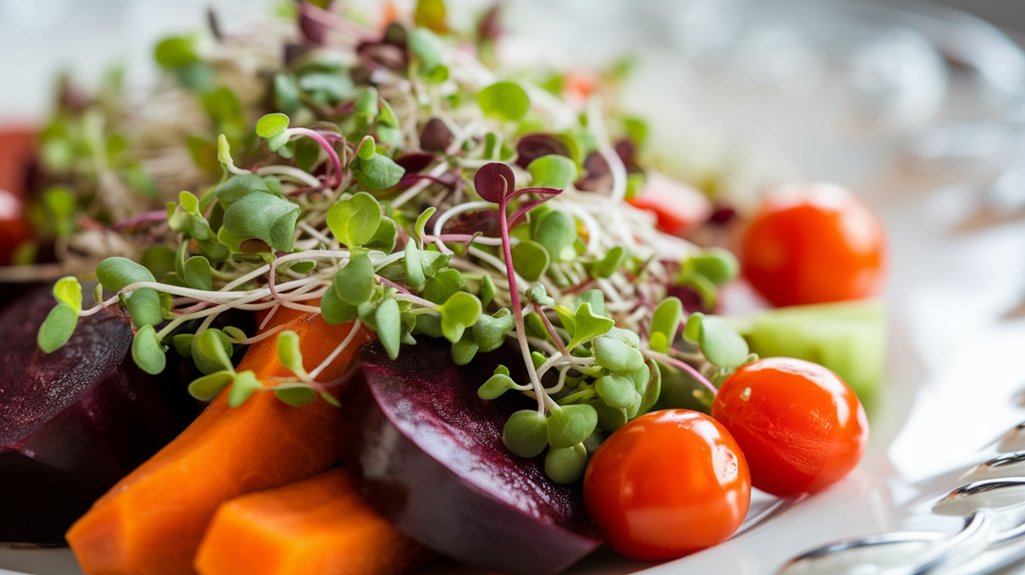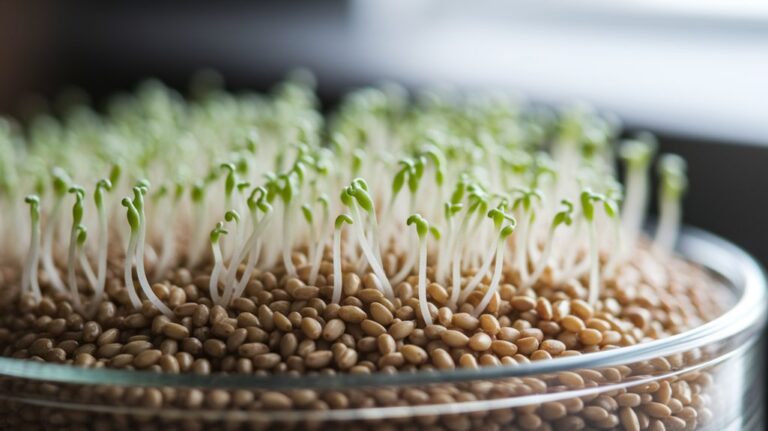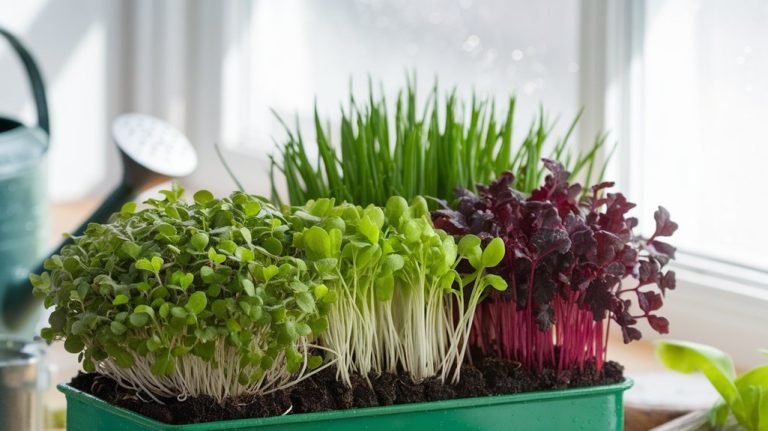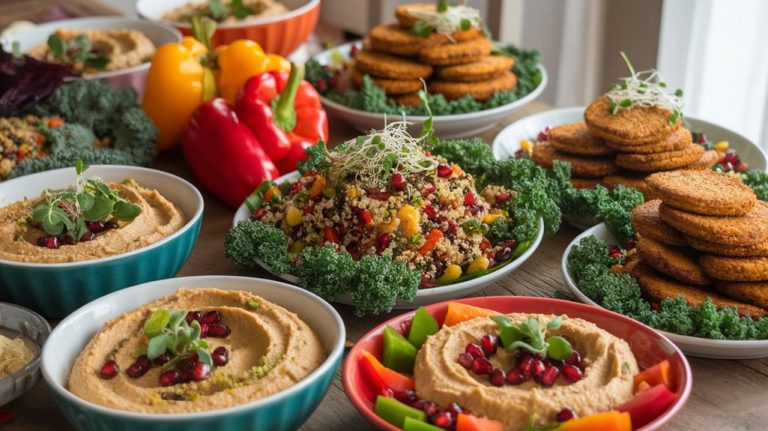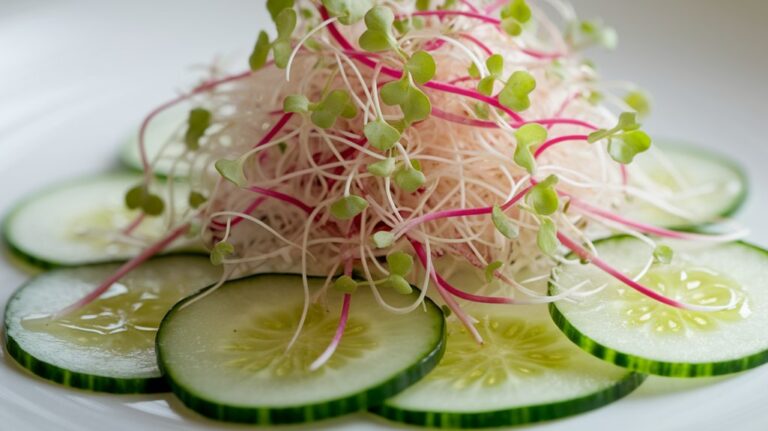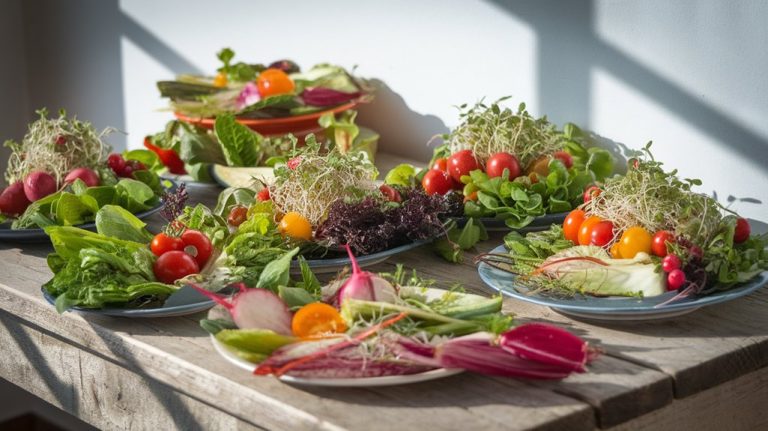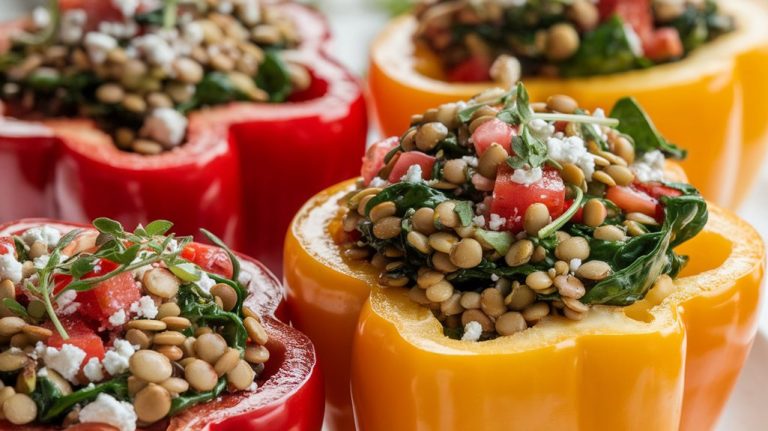Plant-Powered Plates Featuring Vegetables and Fresh Sprouts
Plant-powered plates featuring fresh vegetables and sprouts are packed with vital nutrients that support overall health and wellness. I love how leafy greens, like kale and spinach, boost my immune system, while colorful veggies add flavor and antioxidants. Sprouts, such as broccoli and alfalfa, are nutrient-dense and low in calories, making them a perfect addition to any meal. If you’re curious about more delicious combinations and tips, there’s plenty to explore ahead!
Key Takeaways
- Fresh vegetables and sprouts are nutrient-dense, providing essential vitamins, minerals, and antioxidants for overall health and wellness.
- Incorporate seasonal ingredients into salads, such as arugula in spring or roasted butternut squash in autumn, to enhance flavor and nutrition.
- Grain bowls serve as a versatile base for combining whole grains, roasted vegetables, leafy greens, and protein-rich sprouts for a complete meal.
- Flavorful dressings like basil pesto or cilantro lime vinaigrette can elevate plant-powered dishes while providing additional health benefits.
- Growing your own sprouts at home allows for fresh, flavorful additions to meals, enhancing nutrition and offering unique textures.
The Nutritional Benefits of Fresh Vegetables and Sprouts
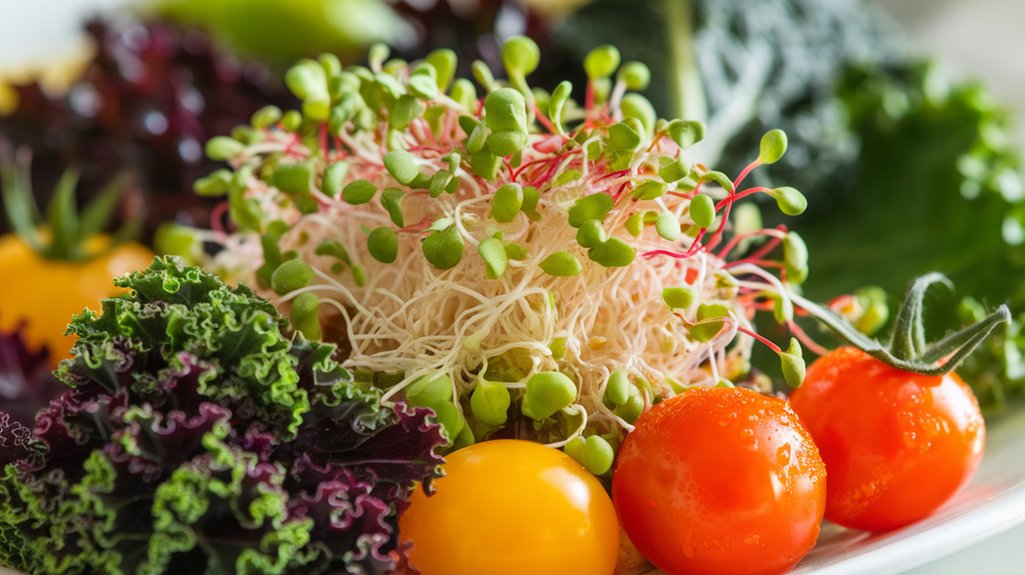
When I think about enhancing my diet, fresh vegetables and sprouts immediately come to mind due to their impressive nutritional profile.
These vibrant foods are packed with essential vitamins, minerals, and antioxidants. For instance, leafy greens like spinach and kale are rich in vitamins A, C, and K, supporting vision and immune function.
Sprouts, such as alfalfa and broccoli, contain high levels of enzymes and protein, promoting digestion and muscle health. Additionally, vegetables like bell peppers and carrots provide beta-carotene, which can improve skin health.
Incorporating a variety of these nutrient-dense foods not only boosts my overall health but also supports weight management. It’s clear that fresh vegetables and sprouts are a delicious way to fuel my body effectively.
Creative Salad Combinations for Every Season
As I explore the world of salads, I find that each season offers unique ingredients that can transform a simple dish into a vibrant culinary experience.
In spring, I love combining fresh arugula with strawberries, goat cheese, and a light balsamic vinaigrette.
Summer’s bounty calls for ripe tomatoes, cucumbers, and fresh basil, drizzled with olive oil and lemon juice.
When autumn arrives, I enjoy roasted butternut squash, kale, and pomegranate seeds, topped with a maple dressing.
In winter, I turn to hearty Brussels sprouts, apples, and walnuts, paired with a tangy mustard vinaigrette.
Each combination highlights the best of the season and keeps my salads exciting and nutritious year-round. Embracing seasonal ingredients truly elevates my salad game!
Hearty Grain Bowls: A Canvas for Plant-Based Ingredients
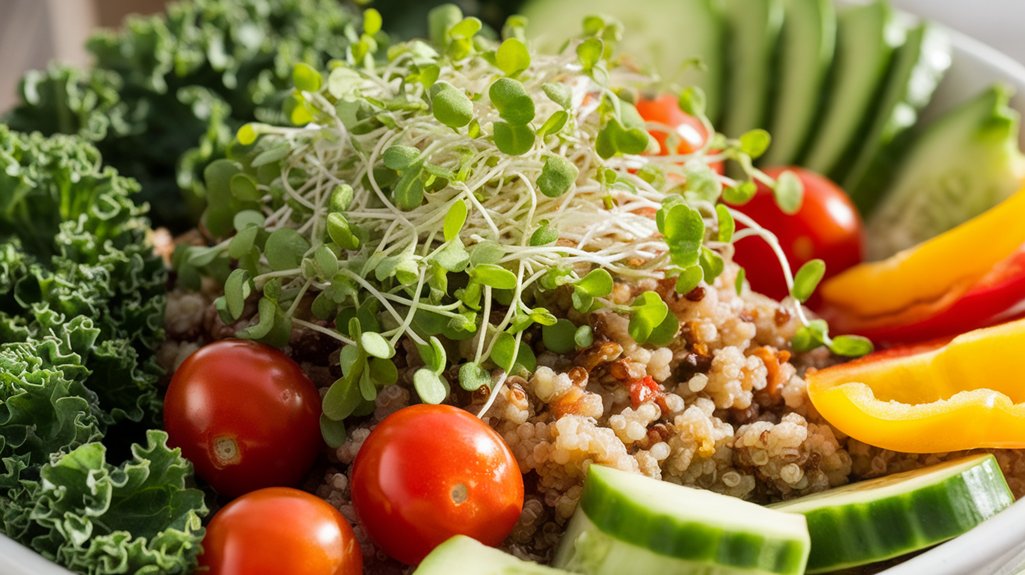
Hearty grain bowls serve as the perfect canvas for showcasing an array of plant-based ingredients, allowing me to create meals that are both satisfying and nutritious.
These bowls are versatile and packed with essential nutrients, making them an excellent choice for any meal. I love combining various grains and toppings to enhance flavor and texture.
Here are some ingredients I often include:
- Quinoa or brown rice for a fiber-rich base
- Roasted vegetables like sweet potatoes or bell peppers
- Leafy greens such as kale or spinach
- Protein sources like chickpeas or lentils
- Fresh herbs and seeds for added nutrition and crunch
With these components, I can whip up a delicious, balanced dish that keeps me energized throughout the day.
Flavorful Dressings and Sauces to Elevate Your Dishes
When I create plant-powered dishes, I know that vibrant herb-infused dressings can truly enhance the flavors.
Zesty citrus-based sauces not only brighten the plate but also add a refreshing twist.
Let’s explore how these simple additions can elevate your meals.
Vibrant Herb-Infused Dressings
While enhancing your meals with vibrant flavors, herb-infused dressings can transform even the simplest dishes into culinary delights.
I love experimenting with fresh herbs like basil, cilantro, and dill to create dressings that burst with flavor. These dressings not only add zest but also provide health benefits. Fresh herbs are rich in vitamins and antioxidants, making them a fantastic addition to any meal.
Here are my go-to herb-infused dressing ideas:
- Basil Pesto: Blend basil, garlic, nuts, and olive oil.
- Cilantro Lime Vinaigrette: Combine cilantro, lime juice, and olive oil.
- Dill Yogurt Sauce: Mix Greek yogurt with fresh dill and lemon.
- Mint and Parsley Dressing: Blend mint, parsley, olive oil, and vinegar.
- Garlic Rosemary Dressing: Infuse olive oil with garlic and rosemary.
Try these and elevate your dishes!
Zesty Citrus-Based Sauces
Building on the vibrant flavors of herb-infused dressings, zesty citrus-based sauces bring a refreshing brightness to your meals. These sauces, made with fresh citrus juices like lemon, lime, and orange, not only enhance the taste but also add a nutritional boost.
Vitamin C-rich citrus can improve iron absorption from plant-based foods, making your meals even healthier.
I love combining citrus with ingredients like garlic, ginger, or tahini for added depth. A simple citrus vinaigrette can transform a salad, while a tangy citrus glaze can elevate roasted vegetables.
Experimenting with different citrus varieties allows me to tailor flavors to my liking. By incorporating zesty citrus-based sauces, you’ll elevate your dishes and create a delightful culinary experience.
Cooking Techniques to Bring Out the Best in Vegetables
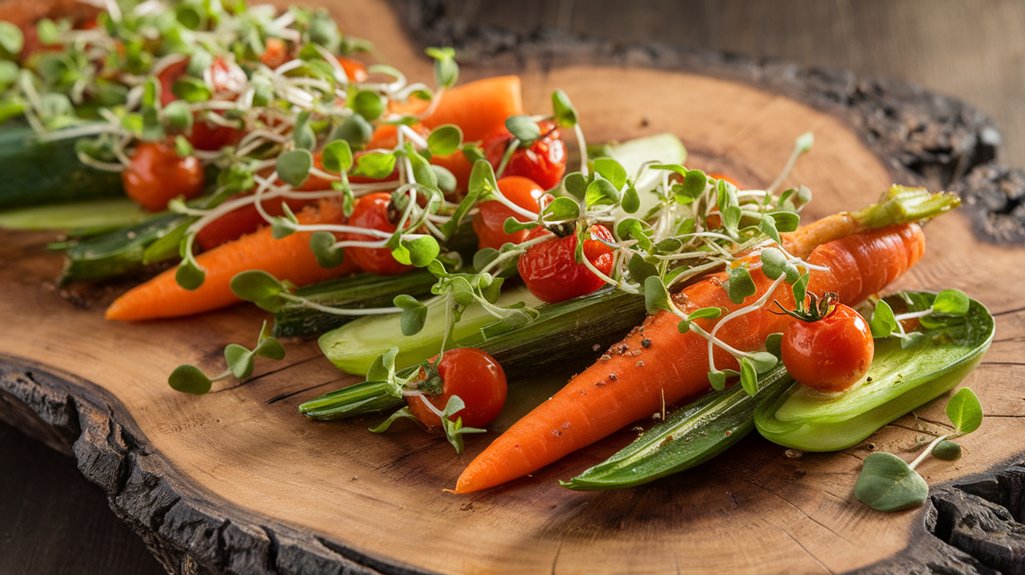
To truly elevate the flavors of vegetables, employing the right cooking techniques is essential.
I’ve found that certain methods can really enhance their taste and texture. Here are some techniques I recommend:
- Steaming: Preserves nutrients while keeping vegetables tender and vibrant.
- Roasting: Caramelizes the natural sugars, adding depth and sweetness.
- Sautéing: Quickly cooks veggies in a little oil, enhancing their flavor without losing moisture.
- Blanching: Briefly boiling vegetables followed by ice water helps maintain color and crispness.
- Grilling: Adds a smoky flavor while creating charred edges that enhance taste.
Incorporating Sprouts Into Your Daily Meals
Incorporating sprouts into my daily meals not only boosts nutritional value but also adds a delightful crunch and unique flavor. I love tossing them into salads, sandwiches, or stir-fries. Rich in vitamins and minerals, sprouts are an easy way to enhance any dish.
Here’s a quick guide on some common sprouts and their benefits:
| Sprout Type | Benefits |
|---|---|
| Alfalfa Sprouts | High in vitamin K |
| Broccoli Sprouts | Contains sulforaphane |
| Mung Bean Sprouts | Great source of protein |
| Radish Sprouts | Rich in antioxidants |
| Lentil Sprouts | Packed with fiber |
Adding these nutrient powerhouses to my meals keeps my diet varied and exciting. Give them a try—you won’t regret it!
Seasonal Produce: What to Eat and When
As the seasons change, I find it essential to embrace the bounty of seasonal produce, which not only tastes better but is often more nutrient-dense.
Eating in sync with nature not only supports local farmers but also enhances my meals with vibrant flavors. Here’s what I love to eat during each season:
- Spring: Asparagus, peas, and radishes
- Summer: Tomatoes, zucchini, and bell peppers
- Fall: Pumpkins, sweet potatoes, and apples
- Winter: Kale, Brussels sprouts, and citrus fruits
Incorporating these seasonal ingredients not only boosts my health but also keeps my meals exciting and varied.
Tips for Growing Your Own Sprouts at Home
Growing your own sprouts at home is a rewarding and nutritious endeavor.
I recommend starting with easy varieties like alfalfa or broccoli, which thrive quickly and offer great flavor.
You’ll also need basic sprouting equipment, such as a jar or a dedicated sprouter, to ensure success in your home garden.
Choosing Sprout Varieties
When I think about sprout varieties, the vast options available can be both exciting and daunting. Each type of sprout offers unique flavors and nutritional benefits, making it essential to choose wisely.
Here are some factors I consider when selecting sprout varieties to grow at home:
- Nutritional Value: Look for sprouts high in vitamins and minerals, like broccoli or alfalfa.
- Flavor Profile: Experiment with varieties such as radish for a spicy kick or pea shoots for sweetness.
- Growth Speed: Some sprouts, like mung beans, grow quickly, while others may take longer.
- Texture: Consider the crunchiness of the sprout; for instance, lentils offer a delightful crunch.
- Culinary Uses: Think about how you’ll use them in dishes, from salads to sandwiches.
Happy sprouting!
Sprouting Equipment Essentials
To successfully grow your own sprouts at home, having the right equipment makes all the difference. I recommend starting with a sprouting jar or a dedicated sprouter, which allows for proper drainage and airflow.
You’ll also need a fine mesh lid—this keeps seeds from escaping while letting excess water drain.
Make sure you have a good source of quality seeds; organic options are often best. Additionally, a measuring cup for soaking seeds and a spray bottle for misting can be helpful.
Finally, keep your sprouts in a warm, dark place for the first few days, then move them to indirect sunlight for a day or two before harvesting. With these essentials, you’ll enjoy fresh, homegrown sprouts in no time!
Frequently Asked Questions
What Are the Best Vegetables for Beginners to Start Cooking With?
When starting out with cooking, I’d recommend focusing on a few easy-to-handle vegetables. Carrots, bell peppers, and zucchini are fantastic; they’re versatile and quick to cook.
I also love using spinach, which wilts down easily and adds nutrition to many dishes.
Potatoes are a great staple too, whether you’re roasting, mashing, or boiling them.
These veggies not only taste great, but they’re also forgiving for beginners, making cooking enjoyable and rewarding.
How Can I Store Fresh Sprouts to Maintain Their Freshness?
To store fresh sprouts and keep them crisp, I usually place them in a breathable container, like a mesh bag or a paper towel-lined bowl.
I make sure to keep them in the fridge, ideally in the vegetable crisper.
I also avoid washing them until I’m ready to use them, as excess moisture can lead to spoilage.
With these tips, my sprouts stay fresh and ready for my meals!
Are There Any Common Allergens Related to Sprouts and Vegetables?
When it comes to sprouts and vegetables, I’ve learned that certain allergens can be a concern. Common allergens include soybeans in soybean sprouts and various nuts in mixed vegetable dishes.
Additionally, some people may react to certain types of cruciferous vegetables like broccoli or cabbage. It’s crucial to be aware of these potential allergens, especially if you or someone you’re serving has known sensitivities.
Always check labels and consult with a healthcare professional if unsure.
What Kitchen Tools Are Essential for Preparing Plant-Based Meals?
When preparing plant-based meals, I’ve found a few essential kitchen tools really make a difference.
A sharp knife is crucial for chopping vegetables efficiently. A sturdy cutting board provides a stable surface. A good blender or food processor allows me to create smooth soups and sauces.
Don’t forget measuring cups and spoons for accuracy!
Lastly, a steamer or a pot with a lid helps with cooking vegetables perfectly while retaining their nutrients.
How Do I Safely Wash and Prepare Sprouts for Consumption?
To safely wash and prepare sprouts, I start by rinsing them under cool running water for several minutes.
I gently shake off excess water and place them in a clean bowl. It’s essential to remove any damaged or wilted sprouts.
After that, I recommend soaking them in a vinegar solution for a few minutes to kill any bacteria.
Finally, I give them another rinse before using them in my meals.
Conclusion
Incorporating plant-powered plates into your meals not only enhances your diet with essential nutrients but also keeps your meals exciting and flavorful. By experimenting with seasonal vegetables, creative salads, and hearty grain bowls, you’ll discover a world of culinary possibilities. Don’t forget the benefits of fresh sprouts—they’re a powerhouse of nutrients. So, whether you’re growing your own or simply enjoying what’s in season, embracing these ingredients can transform your meals and your health.

